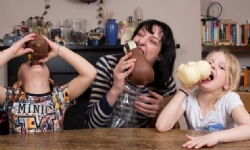Blog
Mar
10
Why and How to Celebrate Easter?
Posted by
at
14:28

It doesn't seem like five minutes since Christmas and here we are celebrating Easter. Being a born chocoholic I need no excuse to eat the stuff and what better way to celebrate Easter than a large Egg made of Chocolate? But how did it all start and why an Egg and why Chocolate?
Early Beginnings
Most people think that a chocolate egg at Easter is a modern day thing, probably introduced in the middle 20th Century. In fact chocolate Easter Eggs first started to appear in the early 1800's although they were fairly basic with gritty dark chocolate and a world apart from the modern day ones we eat today. It wasn't until 1873 that the first mass-produced egg appeared, courtesy of Cadbury's of course, and we had to wait until 1905 for the first milk chocolate egg to appear.
First the Egg
So, why an Egg and why at Easter? Well that's easy because the egg was viewed as a symbol of new life and fertility throughout the ages and used by many ancient cultures during their spring festivals. In Pagan times, long before Christianity took the symbol, the egg was believed to ward off evil, but it also represented life bursting forth just as Spring did after a long hard winter.
In Medieval Europe, eggs were forbidden during Lent, so Eggs laid during that time were boiled or otherwise preserved. Once Easter arrived, these eggs were then the mainstay of the Easter meal and a prized gift for children and servants alike.
A pregnant Roman woman carried an egg on their person to foretell the sex of their unborn children, while French brides stepped upon an egg before crossing the threshold of their new homes. Old Polish legends firmly attached the egg to the Easter celebrations and one folklore tells of the Virgin Mary giving eggs to the soldiers guarding the cross which held Jesus.
Decorating the Eggs
During the middle ages it became custom to decorate your egg (mainly Duck or Goose) with dye, paint or other decorations and competitions were held to find the best Easter Egg. Various games would also take place to lighten things for the children after the sombre mood of Lent. Parents would hide eggs for the children to find and so started the first Easter Egg Hunts which still take place today. Egg Rolling was also popular as a way of using up the eggs that had stock piled during Lent. A large hill was needed to add to the fun and the most famous egg roll still taking place today is the one on the White House lawn.
Around the World
In Greece, the eggs were painted bright red to symbolize the blood of Jesus, with pictures of Christ, the Virgin Mary and other holy figures being painted on. Germans gave green eggs as a Holy Thursday and hung hollow eggs on trees. Hollow eggs were created by piercing the shell with a needle and blowing the contents. Austrians placed tiny plants around the eggs and then boiled them. When the plants were removed, white patterns were created. In Poland, eggs were painted gold or silver while in the Ukraine eggs were waxed and patterns created with the wax being reapplied to seal the design.
Famous Eggs
The household accounts of Edward I, for the year 1290, recorded an expenditure of eighteen pence for four hundred and fifty eggs to be gold leafed and coloured for Easter gifts. The most famous decorated Easter Eggs were made by the well known goldsmith, Peter Carl Faberg�. In 1883, the Russian Czar, Alexander, commissioned Faberg� to make a special Easter gift for his wife, the Empress Marie. This egg was actually not a real egg, as the outside shell was made of platinum and enamelled white, which opened to reveal a smaller gold egg. This in turn, opened to display a golden chicken and a jewelled replica of the Imperial crown. The Czarina was so delighted with this egg that further eggs were commissioned every Easter. In later years Nicholas II, Alexander's son, continued the custom and fifty seven eggs were made in all by Faberg�.
Chocolate
In the 17th Century, artificial eggs were made, using various materials, as these made excellent presents or gifts. These became popular and the first manufactured eggs started to appear, so it was only a matter of time before chocolate was used to create an Easter Egg. The first chocolate Eggs were solid and a paste was used made from ground roasted Cacao Bean. Germany and France produced these, but was quickly followed by the rest of Europe with the eggs being hollowed out.
By the turn of the 19th century the discovery of the modern chocolate making process and improved mass manufacturing methods meant that the hollow moulded egg was the most popular gift for Easter, but it wasn't until the 1960's that this was established world wide.
Easter Bunny
The Rabbit or Hare was often used in Spring celebrations as a sign of fertility due to their frequent births. It was used in Germany first, with German immigrants taking the tradition to America, particularly Pennsylvania, were it spread to a much wider public. Sometimes the Easter Bunny was used to hide the Eggs for the Easter Hunt and cakes and biscuits were baked in bunny shapes. Of course today you are more likely to find a chocolate shaped Bunny or Hare.
So I hope this Easter you get a nice Chocolate Egg or two but remember that Lent does not finish until Easter Sunday so you can't eat the Eggs before then!

